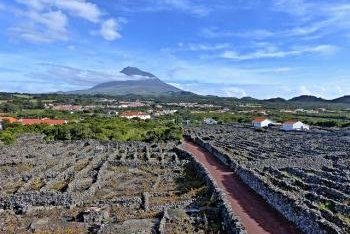
I visited this WHS in October 2015. This is undoubtedly my favourite vineyard culture WHS so far and I have visited quite a few. It's unique as the vines literally grow on volcanic rock and are pretty much the only thing that can be grown by man on this remote volcanic island. To reach Pico, I flew from Lisbon to Sao Miguel Island and then from Sao Miguel Island to Pico Island. The airport is the closest building/structure to the inscribed area which can be divided in 3 areas. The Criacao Velha is right between the Pico volcano and the Atlantic coast just opposite of Faial Island. This is where there are most black basalt walls arranged in the so-called currais that help protect the vines from the ocean. The currais form a network of small squarish or semicircular plots for wine-growing. The vineyards that are subdivided by double walls with a height of not more than 1 metre, with intermediate portals, are called jaroes. The best way to visit is by walking the Vinhas da Criacao Velha trail which passes through the inscribed area and ends by the lava coast. Around Candelaria, is the second part of the inscribed area where you can see the so-called canadas. These are volcanic vineyards with a larger surface area and mostly with less rock than in Criacao. Most canadas are subdivided into currais and traverses which prevent wind piping and several of them reach very close to the sea shore. Nearby there is the Pico Wine Museum which is housed in the former Carmelite convent and where you can taste some Pico wine. My favourite were the aptly named red wine of Basalto and the white wine of Curral Atlantis. If you visit on Sundays, the entrance is free. The third and final inscribed area is towards the Northwestern part of the island of Pico, near the capital Madalena to an area known as Bandeiras. Here there are more vineyards with black stone walls, tidal wells, rilheiras or ox-cart ruts over lava slabs from former wine transportation methods, as wells as rola-pipas or ramps carved in volcanic stone to facilitate the transport of wine barrels to the port. Near Bandeiras, it's worthwhile visiting the Vineyard Culture Interpretation Centre which costs 7 euros and is highly informative with cellars, distilleries, warehouses, manorial homes, shelters and a quaint chapel. There are 3 reconstructed mills on the island of Pico: one in Criacao Velha, one near Sao Joao and another near Madalena. Having a rental car is a must in Pico and really worth it as the world heritage site is just the cherry on the cake really of what the island has to offer. I spent 3 incredible days on Pico Island and if I visit the Azores again I would certainly love to spend a week again in Pico which is the second largest island of the archipelago. The vegetation on the island is almost pristine with less than 5000 people living there. There are great hiking trails and fantastic birdwatching opportunities with several endemic species (such as the Western Azores Goldcrest). Last but certainly not least, there 27 species of cetaceans have been spotted so far off the coast of Pico island including the Blue Whale. I was very lucky to experience a pod of 8 sperm whales socialising and one of them dived just in front of our zodiac, fluking its enormous tail. We observed for more than an hour before spotting 2 species of dolphins: a solitary short-beaked dolphin and a score of bottlenose dolphins which escorted us back to the harbour of Lajes. Truly magical!
More on
Comments
No comments yet.
